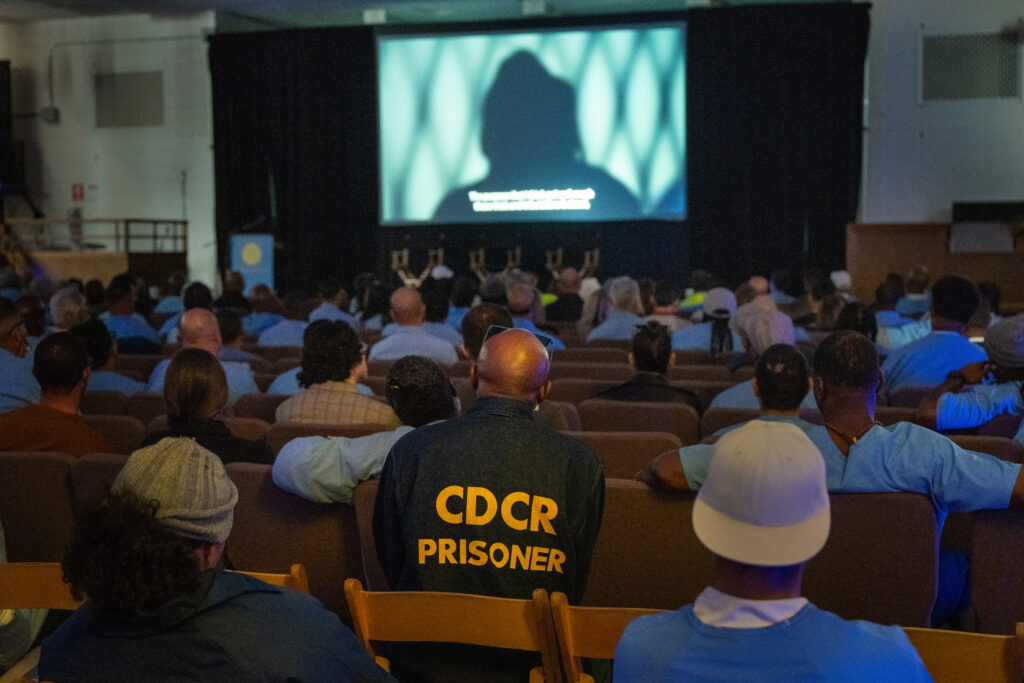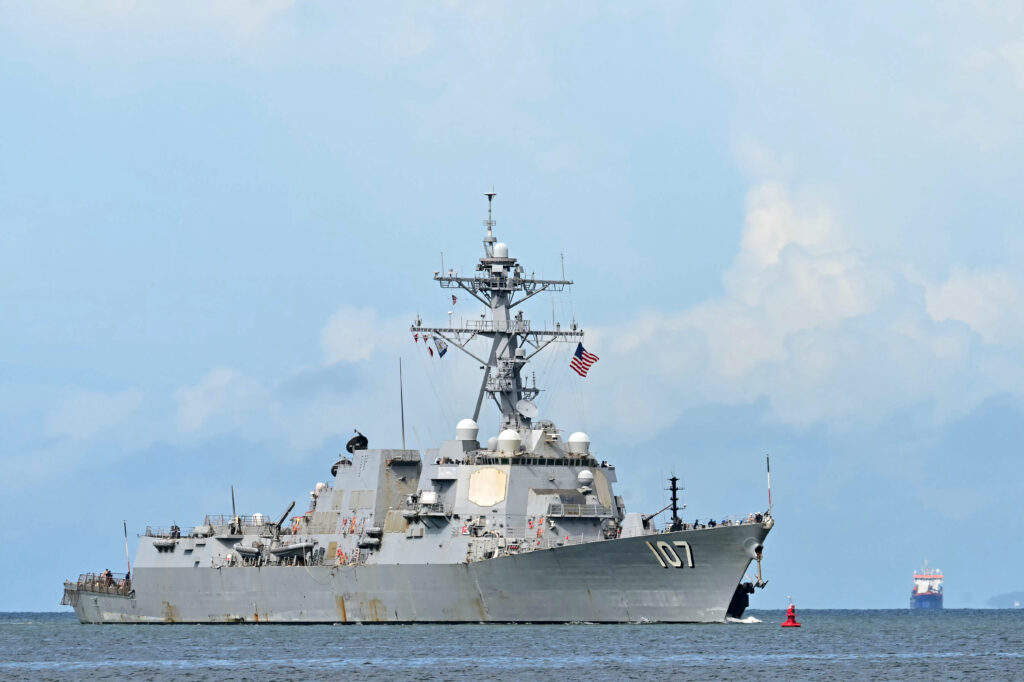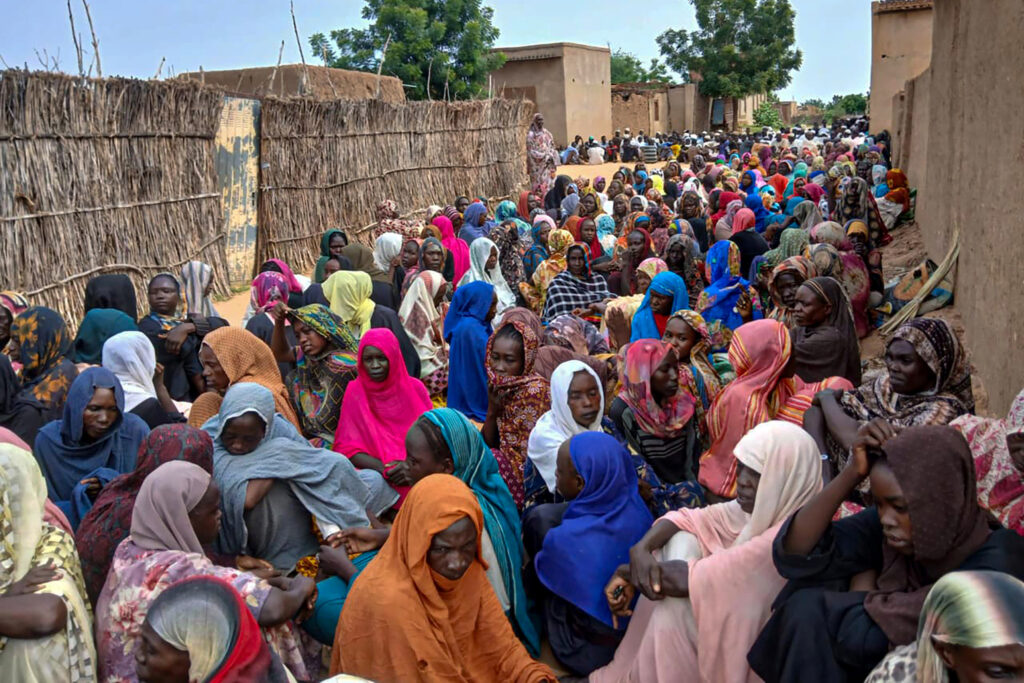Prison film fest brings Hollywood and healing to US jailhouse
Held inside a notorious prison among some of California’s most dangerous felons, the San Quentin Film Festival is not your typical Hollywood affair.Red-carpet interviews take place just yards (meters) away from a now dormant execution chamber where hundreds of death-row inmates met grisly ends.Convicted murderers sit alongside famous actors and journalists, applauding films made by their fellow inmates.Among them is Ryan Pagan, serving 77 years for first-degree murder.”I always wanted to be an actor — but unfortunately that’s not the life I ended up living,” explains Pagan, prison tattoos peeking out from the short sleeves of his jailhouse-issue blue shirt.His film “The Maple Leaf,” made behind bars, is competing for best narrative short film — a category only for currently or formerly incarcerated filmmakers.Pagan, 37, was a teen when he committed his crime, and hopes his new skills directing movies could one day offer “a pipeline to Hollywood, to employment.”Though it did not win, the movie — about a self-help group in which prisoners tackle guilt and shame — won high praise from a jury including director Celine Song (“Past Lives”) and actor Jesse Williams (“Grey’s Anatomy.”)”Right now, I’m just doing the work and rehabilitating myself. Part of the story of ‘The Maple Leaf’ is about guys like me,” he says.- ‘Healing’ -The oldest prison in California, San Quentin was for decades a maximum-security facility that hosted the nation’s biggest death row — and a famous concert by Johnny Cash in 1969.It has become a flagship for California penal reform, and no longer carries out executions.Rehabilitation programs include a media center where prisoners produce a newspaper, podcasts and films. The projects are intended to provide employable skills, as 90 percent of inmates will one day be released.The festival, launched last year, offers inmates a chance to meet mainstream filmmakers from the outside.Founder Cori Thomas, a playwright and screenwriter, had volunteered at the prison for years, and wanted a way to show her Hollywood peers the “exceptional work” being made in San Quentin.”The only way would be for them to come in here to see it,” she realized.After two successful editions, the festival will expand to a women’s prison in 2026.- ‘Warning Signs’ -San Quentin’s film program is also a chance for inmates to confront their often brutal pasts.Miguel Sifuentes, 27 years into a life sentence for an armed robbery in which his accomplice killed a police officer, says creating short film “Warning Signs” was “a transformative healing experience.”He plays an inmate contemplating suicide. Total strangers in prison who watched the film later approached him to open up about their own suicidal thoughts, he says.”It really wasn’t like acting — it was just speaking from a real place of pain,” Sifuentes said.Prison warden Chance Andes told AFP that cathartic activities like filmmaking and events like the festival help “reduce the violence and the tension within the walls.”Inmates who cause fights or otherwise break prison rules temporarily lose their chance to participate. Andes says these lessons resonate after the prisoners are released.”If we send people out without having resolved their trauma and having no skill set, no degree, no schooling, they’re more likely to reoffend and cause more victims,” he says.- ‘Grateful’ -Even rehabilitation-focused prisons like San Quentin remain dangerous places.”We’ve had assaults where nurses have been hurt by patients,” said Kevin Healy, who is a union president and trains staff at San Quentin.”It’s a prison… it comes with the territory.”Overhead circling the courtyard is a narrow walkway, where guards with deadly rifles can appear at the first sign of unrest.But it is a far cry from the terrifying maximum-security prisons where both Pagan and Sifuentes began their sentences, and where Sifuentes nearly died after being stabbed.At least on this sunny festival day, as incarcerated musicians play cheerfully in the courtyard, that violence feels temporarily at bay.”Honestly, I hate to say ‘I’m grateful to be at this prison,’ says Pagan.”But in a sense I am.”
Caracas s’insurge contre l’arrivée d’un bateau de guerre américain à Trinité-et-Tobago
Caracas s’est insurgé dimanche contre la présence d’un navire de guerre lance-missile américain à Trinité-et-Tobago, archipel situé à une dizaine de kilomètres du Venezuela, estimant qu’il s’agissait “d’une provocation” pouvant mener à une “guerre dans les Caraïbes”.La venue de l’USS Gravely dans la capitale, Port-d’Espagne, ainsi que d’une unité de marines, officiellement pour des exercices avec l’armée trinidadienne, avait été annoncée jeudi par le gouvernement de ce pays anglophone de 1,4 million d’habitants. Elle survient alors que le président américain Donald Trump, qui a aussi autorisé des actions clandestines de la CIA sur le sol vénézuélien, accentue sa pression sur son homologue Nicolas Maduro.Washington a déployé sept navires de guerre dans les Caraïbes et un dans le golfe du Mexique, officiellement dans le cadre d’une opération contre le narcotrafic, visant particulièrement le Venezuela et Nicolas Maduro.Le président Trump a aussi annoncé l’arrivée du porte-avions Gerald R. Ford, le plus grand au monde.Caracas estime que la visite de l’USS Gravely est “une provocation militaire de Trinité-et-Tobago en coordination avec la CIA pour provoquer une guerre dans les Caraïbes”.Le pouvoir vénézuélien, qui annonce régulièrement démanteler des complots réels ou imaginaires, assure aussi avoir “capturé un groupe de mercenaires” liés à “la CIA” et découvert la préparation “d’une attaque sous faux drapeau (…) visant à générer un affrontement militaire complet contre notre pays”.Donald Trump accuse son homologue vénézuélien d’implication directe dans le trafic de drogue, ce que ce dernier dément formellement. Pour M. Maduro, Washington se sert du trafic de drogue comme prétexte “pour imposer un changement de régime” et s’emparer des importantes réserves de pétrole de son pays.- “Entre deux murs” -A Port-d’Espagne, où le destroyer est arrivé dimanche vers 9H (13H GMT) certains soutiennent la présence américaine si près des côtes vénézuéliennes. “C’est pour aider à nettoyer les problèmes de drogue qui sont sur le territoire” vénézuélien, estime Lisa, une habitante de 52 ans qui préfère ne pas donner son nom de famille. “C’est pour la bonne cause, beaucoup de gens seront libérés de l’oppression” et du “crime”, ajoute-t-elle.De nombreuses personnes interrogées expriment cependant une inquiétude face à l’arrivée du navire. Le président Trump a évoqué des frappes contre des cartels sur le territoire vénézuélien et dit avoir autorisé des opérations clandestines sur le sol du pays sud-américain.”S’il arrivait quelque chose entre le Venezuela et l’Amérique (…) nous pourrions finir par recevoir des coups”, redoute Daniel Holder, 64 ans, opposé à la stratégie de son gouvernement.La Première ministre de Trinité-et-Tobago, Kamla Persad-Bissessar, est un fervent soutien de M. Trump, et a adopté dès son accession au pouvoir en mai un discours virulent contre le pouvoir vénézuélien ainsi que contre l’immigration et la criminalité vénézuéliennes dans son pays.Elle devrait laisser Washington et Caracas régler leur différend “au lieu d’essayer de s’interposer”. C’est comme “être entre deux murs”, soupire M. Holder.- “Alarmant” -Les Etats-Unis mènent depuis début septembre, essentiellement dans les eaux caribéennes mais aussi dans le Pacifique, des frappes aériennes contre des embarcations présentées comme celles de narcotrafiquants.Jusque-là, dix ont été revendiquées. Elles ont tué au moins 43 personnes, selon un décompte de l’AFP basé sur des chiffres du gouvernement américain.Deux Trinidadiens auraient été tués mi-octobre dans l’une d’elles, selon leurs familles. Les autorités locales n’ont ni confirmé ni infirmé ces décès. Des experts ont remis en question la légalité des frappes dans des eaux étrangères ou internationales, contre des suspects qui n’ont pas été interceptés ou interrogés.”Nous n’avons pas besoin de tous ces meurtres et de ces bombardements, nous avons juste besoin de paix… et de Dieu”, affirme auprès de l’AFP Rhonda Williams, réceptionniste trinidadienne de 38 ans.Randy Agard, citoyen américain en visite sur l’archipel, dit avoir des “émotions mitigées” à la vue du navire de guerre envoyé par son pays. Les Etats-Unis “essaient de s’immiscer partout pour tenter de contrôler tout le monde”. Ce n’est pas “pour la sécurité des gens, c’est juste une question de contrôle”, dit cet homme de 28 ans.
Sudan’s RSF claims control of last army stronghold in DarfurSun, 26 Oct 2025 22:58:01 GMT
Sudan’s paramilitary Rapid Support Forces (RSF) said Sunday it had seized full control of El-Fasher, the last major city in the expansive Darfur region not in its hands, in a potential turning point in the country’s unrelenting civil war.The announcement came just hours after it claimed to have captured the army’s main base in the …
Présidentielle ivoirienne: les premiers résultats tombent, scores écrasants pour Ouattara
Les premiers résultats de la présidentielle ivoirienne étaient égrenés par la Commission électorale dimanche, avec des scores écrasants dans certains départements, souvent au-delà de 90%, pour Alassane Ouattara qui file sans surprise à 83 ans vers un quatrième mandat.Près de 9 millions étaient appelés à voter samedi, dans ce pays premier producteur mondial de cacao et redevenu un pôle de stabilité au sein d’une Afrique de l’ouest secouée par les putschs et les attaques jihadistes.La Commission électorale indépendante (CEI) publie au fil de la journée et de la soirée les résultats pour chacun des 111 départements ainsi que le district d’Abidjan et de la capitale Yamoussoukro. Les résultats compilés devraient être connus dans la nuit de dimanche à lundi. Dans le nord, région à dominante malinké, l’ethnie du chef de l’Etat, comme à chaque présidentielle, il a fait carton plein.98,44% à Seguela, 99,7% à Kani ainsi que dans son fief de Kong, 98,1% à Ferkessedougou ou encore 97,8% à Sinématiali, à chaque fois avec une participation approchant les 100% dans ces zones rurales du pays. Même à Dabakala, où l’un de ses rivaux de samedi Jean-Louis Billon est élu député, le président a dépassé les 92%.Dans les zones du sud et de l’ouest, où beaucoup de bureaux étaient déserts, les chiffres de participation étaient plus faibles, mais “ADO” restait en tête. Dans la commune cossue de Cocody à Abidjan, moins de 20% des électeurs se sont par exemple déplacés, et M. Ouattara a recueilli 68% des voix.L’un des quatre autres candidats, Jean-Louis Billon, devant ces “premiers résultats”, a adressé ses “félicitations au président sortant pour sa réélection”. “Si l’élection s’est déroulée dans un climat globalement apaisé et sécurisé (…), le processus n’a pas été exempt d’irrégularités”, a jugé M. Billon, s’inquiétant d'”un très faible taux de participation, particulièrement dans certaines régions”. Le chiffre officiel de la participation nationale n’est pas encore connu mais le président de la Commission électorale indépendante (CEI), Ibrahime Kuibiert Coulibaly a estimé samedi soir qu’elle devrait “avoisiner les 50%”.Ces scores écrasants et le désintérêt d’une partie des Ivoiriens pour le scrutin s’explique en grande partie par l’absence de ses deux principaux rivaux. Ni le banquier international Tidjane Thiam, ni l’ancien président Laurent Gbagbo n’étaient sur les bulletins de vote samedi, tous deux ayant été écartés du scrutin et radiés des listes électorales, le premier pour des problèmes de nationalité, le second pour une condamnation pénale.”On observe une fracture très claire entre le nord et le sud. Le taux réel de participation est plus faible qu’annoncé. On peut émettre des doutes sur la légitimité d’un président élu dans ces conditions”, a déclaré à l’AFP Simon Doho, chef de file des députés du PDCI, le parti de M. Thiam.- Deux morts samedi -De quoi rappeler la dernière élection, en 2020, où M. Ouattara avait obtenu 94% des voix avec une participation légèrement au-dessus de 50%, dans un scrutin alors boycotté par les principaux opposants.Ce samedi, quatre adversaires lui faisaient face, mais aucun n’a de chance d’arriver à un second tour, faute de soutien d’un grand parti ou de moyens financiers importants. Si le scrutin s’est déroulé globalement dans le calme, des incidents ont été signalés dans 2% des lieux de vote, soit environ 200 endroits, selon un bilan des forces de l’ordre transmis à l’AFP.Des heurts ont éclaté dans plusieurs localités du sud et de l’ouest, mais sans “incidence majeure sur le déroulement du scrutin”, selon le ministre de l’Intérieur Vagondo Diomandé.Selon une source sécuritaire contactée par l’AFP, une personne de nationalité burkinabè est morte dans la région de Gadouan (centre-ouest) dans des affrontements intercommunautaires, samedi après-midi.Vingt-deux autres ont été blessées, par balle ou arme blanche, l’un d’eux, avec le “pronostic vital engagé” a-t-on appris de même source et les forces de sécurité ont été déployées pour ramener le calme. Un adolescent de 13 ans a été tué “par un tir” provenant d’un véhicule de transport en commun à Gregbeu (centre-ouest), selon cette source.Au total, six personnes sont mortes depuis mi-octobre en marge du processus électoral, dont deux le jour du scrutin. La Côte d’Ivoire est un pays où cohabitent une soixantaine d’ethnies de diverses langues et religions et une large population étrangère principalement venue des pays sahéliens voisins.L’élection présidentielle est toujours synonyme de tensions politiques et intercommunautaires dans l’esprit de nombreux Ivoiriens, après les scrutins de 2010 (3.000 morts) et 2020 (85 morts).Près de 44.000 membres de forces de l’ordre étaient déployés sur tout le territoire et le pouvoir avait interdit les manifestations des opposants inéligibles en octobre, procédant à des centaines d’arrestations pour troubles à l’ordre public notamment.
Italie: l’AS Rome commence à rêver, la Juventus s’enfonce dans la crise
Les tifosi de l’AS Rome commencent à rêver, ceux de la Juventus sont en plein cauchemar: la Roma a rejoint Naples en tête du Championnat d’Italie après son succès dimanche à Sassuolo (1-0), tandis que la Juve, battue par la Lazio (1-0), n’a plus gagné depuis un mois et demi.La Roma ne marque pas beaucoup de buts, mais elle engrange les points, 18 après la huitième journée, soit son meilleur bilan à ce stade de la saison depuis 2013/14.Les Giallorossi ont dominé le promu Sassuolo, mais se sont contentés d’un but, le premier inscrit cette saison en championnat par Paulo Dybala (16e).L’Argentin, après une saison 2024/25 perturbée par des blessures, a offert une sixième victoire à son équipe en reprenant acrobatiquement et instantanément le ballon repoussé par le gardien de Sassuolo après un tir de Bryan Cristante.La Roma a rejoint au sommet de la Serie A Naples, vainqueur la veille de l’Inter (3-1) dans l’affiche du week-end. Mais le Napoli, champion en titre, est leader grâce à sa meilleure différence de buts (+7, contre +5 pour la Roma).Sous la conduite depuis juillet de Gian Piero Gasperini, la Roma encaisse peu de buts, trois, ce qui en fait la meilleure défense de Serie A, mais elle en marque aussi peu, seulement huit.- Tudor sous pression -Autre particularité de cette Roma, elle voyage mieux qu’elle ne joue à domicile, puisqu’elle a concédé ses quatre défaites, deux en championnat, deux en Ligue Europa, dont une contre Lille, au Stade olympique.”Je suis très satisfait, car l’équipe a bien réagi après deux défaites (contre l’Inter et le Viktoria Plzen) cette semaine. La priorité est maintenant de regagner à domicile, il faut récompenser nos tifosi. A la maison, nous devons être plus efficaces”, a espéré Gasperini.Le “Gasp” n’aura qu’à attendre trois jours pour savoir si son discours va être entendu, puisque son équipe reçoit Parme mercredi dans le cadre de la 9e journée.Les trois premiers, Naples, l’AS Rome et l’AC Milan, tenu en échec par Pise (2-2) vendredi à San Siro, se tiennent en un point.La Juve, désormais huitième, accuse six points de retard sur le duo de tête après sa troisième défaite en huit jours, son huitième match de suite sans victoire, toutes compétitions confondues.Les Bianconeri se sont inclinés sur un but de Tomas Basic et sont restés muets pour le quatrième match consécutif.”On est bien sûr déçu, on se sent super mal, mais il manque toujours quelque chose dans le contenu de nos matches (…) Nous sommes tous responsables de cette situation”, a reconnu Igor Tudor qui a assuré “ne pas s’inquiéter pour son futur”.Le technicien croate, arrivé en cours de saison dernière en remplacement de Thiago Motta, pourrait faire les frais de cet effondrement: son équipe, opposée à l’Udinese mercredi, a débuté la saison par trois victoires, mais n’a empoché que trois points lors des cinq dernières journées.Deux autres entraîneurs sont sous pression, car leur équipe court toujours après une première victoire.Le Genoa de Patrick Vieira s’est incliné sur le terrain du Torino (2-1) et reste coincé à la dernière place (3 pts), tandis que la Fiorentina de Stefano Pioli a arraché le nul (2-2) après avoir été menée 2-0 à domicile par Bologne mais reste relégable (18e, 4 pts).





